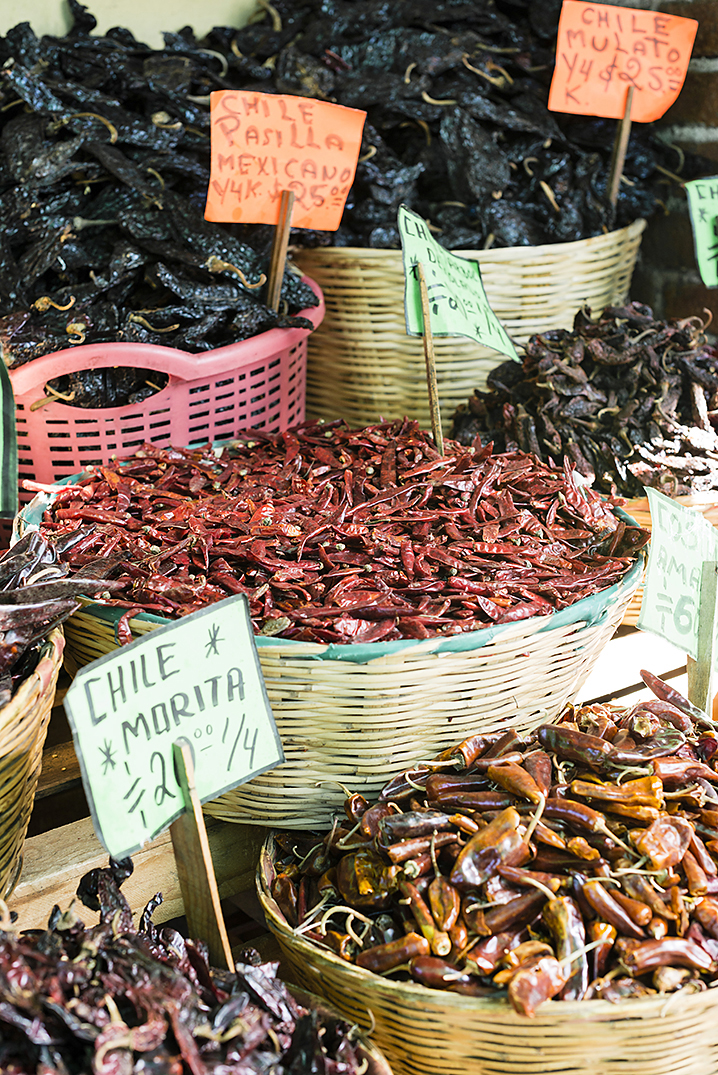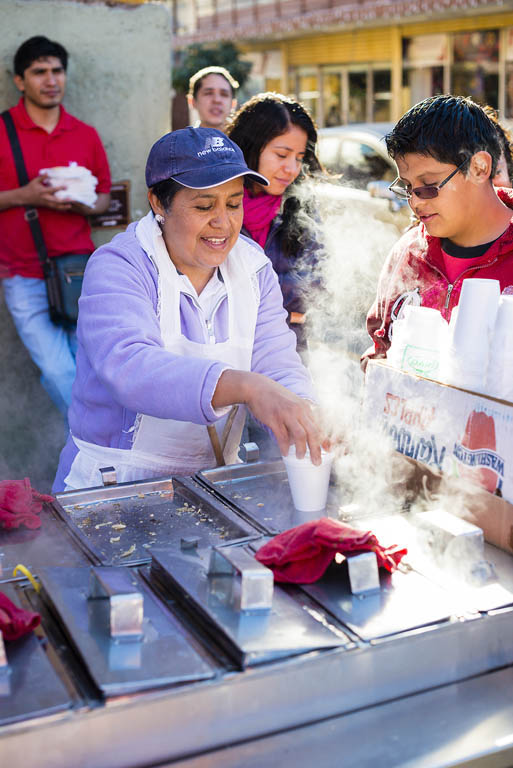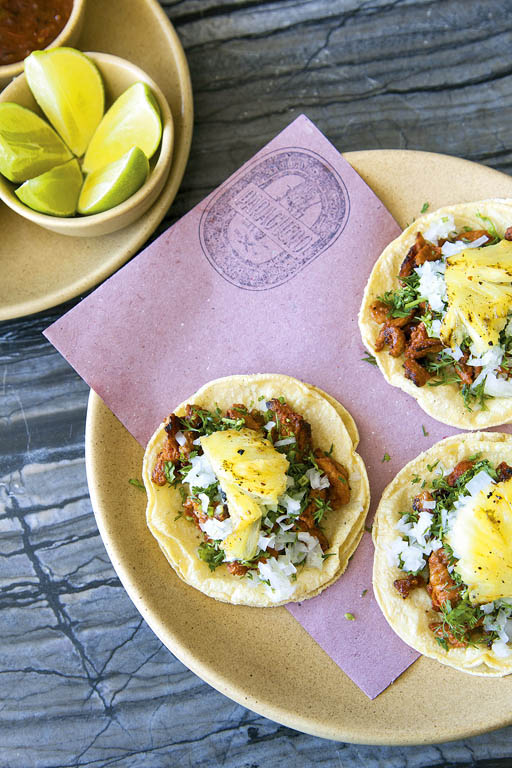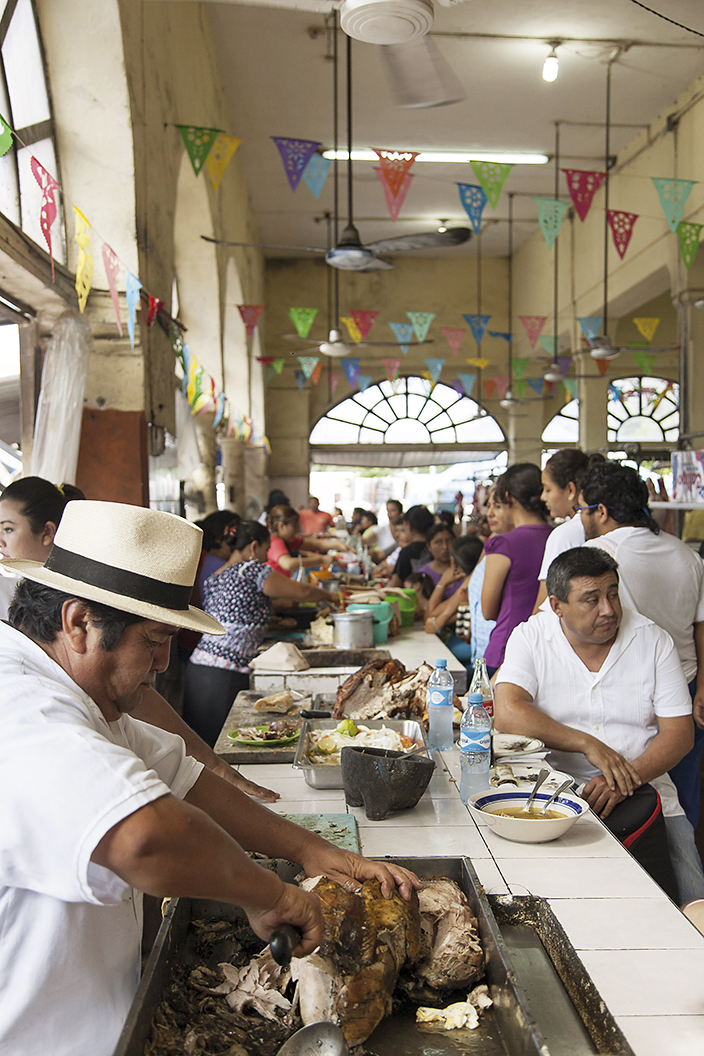Plan Your Trip
Eat & Drink Like a Local
Mexican cuisine is far more tasty, fresh, varied, carefully prepared and creative than you could ever imagine before you start trying it. Venture into the flavors of Mexico, anywhere from simple street taco stands to refined contemporary fusion restaurants, and eating will be a highlight of your trip.
Must-Try Dishes
Traditional dishes that will leave you with the taste of Mexico:
Chiles en nogada
Chiles en nogada comprises green, white and red ingredients, the colors of the Mexican flag: poblano chili, stuffed with minced meat and flavored with spices, topped with a cream sauce and sprinkled with pomegranate seeds.
Tacos al pastor
One of the country’s favorites, tacos al pastor (‘in the style of the shepherd’) is a corn tortilla filled with thinly sliced pork that’s been cooked on a spit, and served with onion and cilantro (coriander).
Mole negro
A Oaxacan specialty, the recipe of this dark, sultry sauce is jealously guarded, and the sauce itself is time-consuming and difficult to make. It tastes of chocolate, spices and...you’ll see!

Food Experiences
Meals of a Lifetime
Quintonil, Mexico City This contemporary gem showcases Mexican ingredients, paraded in multiple courses.
Pujol, Mexico City A multiple-course tasting extravaganza of contemporary Mexican cuisine: reserve weeks ahead.
Alcalde, Guadalajara Acclaimed chef Francisco Ruano’s latest venture is an unmissable contribution to the growing local gourmet scene.
Taco Fish La Paz, La Paz Cheap, basic, no view and – hands down – the best fish tacos in Baja.
Nohoch Kay, Mahahual Beautiful beachfront setting and scrumptious seafood.
Casa Oaxaca, Oaxaca Magically combines Oaxacan and other flavors in delectably origi-nal ways.
Áperi, San Miguel de Allende A cutting-edge, anything-goes experience enjoyed at the kitchen table.
El Presidio, Mazatlan Stellar food and meat dishes served in a beautifully restored 19th-century courtyard.
Ku’uk, Mérida A modern take on Yucatecan cuisine, with gorgeous presentation on slate, leaves and shells.
Cheap Treats
Mexico has one of the world’s great street-food cultures. All over the country, street stands, markets and small eateries dole out endless supplies of filling and nutritious snacks and light meals, morning, noon and night. The busiest stands usually have the tastiest offerings and freshest ingredients.
Foremost are the many varieties of antojito (‘little whim’), light dishes using masa (corn dough). The quintessential antojito is the taco – meat, fish or vegetables wrapped in a tortilla (Mexico’s ubiquitous corn- or wheat-flour flatbread). Delicious varieties include tacos al pastor (with spit-cooked pork), tacos de carne asada (with grilled beef) and tacos de pescado (fish tacos, a favorite on the Pacific coast). There are many more types of antojito and an infinite variety of ingredients that can go into them. The most popular types include:
Quesadillas A tortilla folded in half with a filling of cheese and/or other ingredients.
Enchiladas Lightly fried tortillas with fillings, and covered in a chili sauce.
Tamales A wodge of masa mixed with lard, with stewed meat, fish or veggies in the middle, and steamed in corn husks or banana leaf.
Other common street foods:
Tortas Sandwiches (hot or cold) using a white bread roll.
Elotes Freshly steamed or grilled corn on the cob, usually coated in mayonnaise and often sprinkled with chili powder.
Dare to Try
Grasshoppers (chapulines) Fried with chili powder and garlic; they make a surprisingly munchable snack, especially accompanying a glass of mezcal. Plentiful in Oaxaca.
Corn fungus (huitlacoche) The black mold that grows on some cobs of corn (maize) has a truffle-like texture and has been considered a delicacy since pre-Hispanic times. Available during the mid-year rainy season at Mexico City’s Mercado San Juan and as a sauce or stuffing ingredient at Axitla (map ![]() %739-395-05-19; Av Tepozteco; breakfast M$65-110, mains M$85-195;
%739-395-05-19; Av Tepozteco; breakfast M$65-110, mains M$85-195; ![]() h10am-7pm Wed-Sun;
h10am-7pm Wed-Sun; ![]() v), Tepoztlán.
v), Tepoztlán.
Cow’s-eye tacos (tacos de ojos) Yes, that’s right. Cows’ eyes chopped up, steamed and put into tacos. Soft enough but not especially flavorsome and can be a bit greasy. Found at taco stands around the country and at Los Cocuyos restaurant in Mexico City.
Grubs and worms Ant larvae (escamoles) and maguey worms (gusanos de maguey) are seasonal fare from about March to June in the Puebla-Tlaxcala area. Elsewhere, at Onix in Morelia, you can wrap your tongue around scorpions.

Local Specialties
Central Mexico
Guadalajara is famed for its birria (chili-spiced goat or lamb stew eaten with tortillas, pickled onions, cilantro and salsa) and tortas ahogadas (drowned tortas) – sandwiches of chopped fried pork soaked in a spicy sauce. In Tequila, the town that gave Mexico its most famous drink, you can visit distilleries, or even take one of several express excursion trains from Guadalajara. The city of Puebla has a proudly distinctive cuisine including perhaps Mexico’s single most famous dish – mole poblano, a thick sauce of chilies, fruits, nuts, spices and chocolate, usually served over chicken.
COOKING CLASSES
Estela Silva’s Mexican Home Cooking School Long-established school near Tlaxcala, focusing on local cuisine.
La Casa de los Sabores Classes in cooking meals of Oaxacan and other Mexican origin at one of the best schools in Oaxaca.
La Villa Bonita Courses of several days including accommodations, run by celebrated chef Ana García.
Little Mexican Cooking School Classes on the Riviera Maya, preparing menus from seven different Mexican regions.
Patio Mexica Cooking School Highly recommended classes in local and national favorites.
Los Dos Renowned cooking school in Mérida, specializing in Yucatecan dishes.
Mexico City
The great melting pot of Mexican people and Mexican food, the capital has a vibrant street-food culture, with antojitos everywhere – at street stands, markets and thousands of taco stands. At the other end of the culinary scale, top chefs create fantastic fusion dishes in ultra-contemporary restaurants melding haute-cuisine techniques with traditional Mexican ingredients, especially in the neighborhoods of Condesa, Roma and Polanco.
Oaxaca
This southern state is famed for its unique dishes. Greatest renown belongs to its many moles – rich, thick sauces made with chilies, spices, nuts and often tomatoes, that go over meats. Oaxaca is also the world capital of mezcal, a potent sipping liquor made from agave plants which is enjoying an upsurge in popularity. Tlayudas (crunchy grilled tortillas topped with cheese, lettuce and refried beans) are also known as ‘Mexican pizzas’. A more unconventional local specialty is chapulines (grasshoppers) which are far tastier than they sound.

Yucatán Peninsula
Caribbean flavors and indigenous Maya recipes influence the cuisine of Mexico’s southeast corner. The most famous dish is cochinita pibil – slow-cooked pork marinated in citrus juices and achiote (a spice made from red seeds) and traditionally roasted in a pit in the ground. A staple is the fiery chile habanero – habanero sauce goes well on papadzules (tacos stuffed with hard-boiled eggs and pumpkin-seed sauce). Don’t miss sopa de lima, a soup made from turkey, lime and tortilla pieces.
Veracruz
Two main factors strongly influence Veracruz cooking: its proximity to the ocean (and abundance of seafood), and centuries of Spanish and Afro-Caribbean influence. Standout dishes include huachinango a la veracruzana (red snapper in a spicy tomato sauce), arroz a la tumbada (a kind of paella-like soup), camarones enchipotlados (shrimp in a chipotle sauce) and pollo encacahuatado (chicken in a peanut sauce).


How to Eat & Drink
When to Eat
Desayuno (breakfast) Usually served from 8:30am to 11am, it tends to be on the hearty side. Egg dishes are popular and some Mexicans down serious meaty platefuls.
Comida (lunch) The main meal of the day, usually served between 2pm and 4:30pm and comprising a soup or other starter, main course (typically meat, fish or seafood) and a small dessert. Comida corrida, also known as menú del día, is an inexpensive fixed-price lunch menu.
Cena (dinner) For Mexicans, dinner is a lighter meal than lunch and often not eaten till 9pm. Nearly all restaurants serving dinner open from as early as 7pm though, offering full menus for those who want them.
Snacks At almost any time of day you can grab an antojito or torta at a cafe or street market stall. You can also get sandwiches (toasted) in some cafes.
Where to Eat
In general, restaurantes have full, multi-course menus and a range of drinks to accompany meals, while cafés and cafeterías offer shorter menus of lighter dishes and their drinks may focus on coffee, tea and soft drinks. Other types of eatery:
Comedor ‘Eating room’; usually refers to low-budget restaurants serving simple, straight-forward meals.
Fonda Small, frequently family-run eatery, often serving comidas corridas.
Mercado (market) Many Mexican markets have comedor sections where you sit on benches eating economical, home-style food cooked up on the spot.
Taquería Stall or small eatery specializing in tacos.
Menu Decoder
Our Food Glossary explans dishes you’ll find on Mexican menus and the names of basic foods.
a la parrilla grilled on a barbecue grill
a la plancha grilled on a metal plate
al carbón cooked over open coals
aves poultry
bebidas drinks
carnes meats
empanizado fried in breadcrumbs
ensalada salad
entradas starters
filete fillet
frito fried
huevos eggs
jugo juice
legumbres pulses
mariscos seafood (not fish)
menú de degustación tasting menu
mole rich, thick sauce, made with chilies, spices, nuts, often tomatoes and sometimes chocolate, poured over meats
pescado fish
plato fuerte main dish
postre dessert
salsa sauce
sopa soup
verduras vegetables
